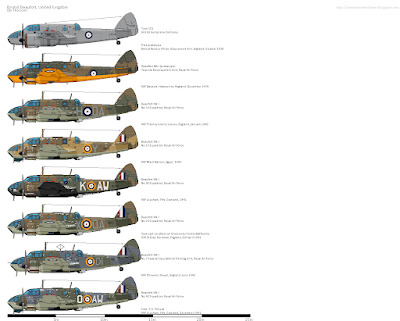The Bristol Beaufort came from a specification of the Air Ministry calling for a general reconnaissance airplane to replace the Avro Anson. It requested a land-based torpedo-bomber powered by two engines. Bristol's design 152 was selected, together with the other contender, the Blackburn Botha, in an unprecedented decision as the Royal Air Force (RAF) was in great need of a torpedo-bomber. In 1936 the type was given green light for mass production. It got the name Beaufort from the Duke of Beaufort. The initial production order was placed for 320 machines, 78 of which were built by Bristol, at their Filton factory and the remaining 242 being built by Blackburn.
The design resembled that of the Bristol Blenheim. It was, however, larger and had a wider wingspan. The fuselage had a longer nose and was taller to accomodate a fourth crew member, making the aircraft considerably heavier. The larger bomb bay was designed to hold a semi-recessed torpedo or an increased bomb-load. Given the heavier weight, the original Bristol Mercury engines, which powered the Blenheim were replaced by the more powerful sleeve-valved Bristol Perseus engine. However, it was determined that even with the Perseus, the Beaufort would be slower than the Blenheim. Therefore, the Bristol Taurus, another sleeve-valve engine was chosen. For those engines, a special NACA-cowling was developed which exhausted air through vertical slots flanking the nacelles under the wings, air flow being controlled by adjustable flaps.
The basic structure introduced many improvements from the previous Blenheim design, making it lighter.
The first prototype was completed in mid-1938. When tested, problems arose with Taurus engines overheating in ground testing, forcing the engineers to design new engine cowlings with circumferential cooling gills. As a result, the first flight was delayed until 15th October 1938. During test flight it was found that undercarriage doors, similar to those of the Blenheim, were causing the aircraft to yaw on landing, so they were removed for subsequent flights. On the second prototype, more conventional split doors were used which left a small part of the tyres exposed when retracted, were installed.
The testing carried out at Boscombe Down, was not satisfactory and that, coupled with the overheating problems of the Taurus engine, gave the Beaufort low manufacturing priority. In fact, it wasn't until November 1939 that production began and it wasn't until January 1940 when the first operational machines were assigned to No. 22 Squadron of RAF Coastal Command.
No. 22 Squadron replaced their outdated Vickers Vildebeest in January 1940. As the Beaufort was a more modern torpedo-bombing platform, it required further extensive training and different flight patterns. Because of those, the first operations carried out by the squadron consisted on laying magnetic mines and dropping some bombs. During one sortie that took place on 7th May 1940, a Beaufort dropped a bomb on a German cruiser anchored off Norderney, Germany.
Sources:
1 https://en.wikipedia.org/wiki/Bristol_Beaufort
2 https://en.wikipedia.org/wiki/List_of_Bristol_Beaufort_operators
3 Hall Park Books - Warpaint 50 - Bristol Beaufort


No comments:
Post a Comment